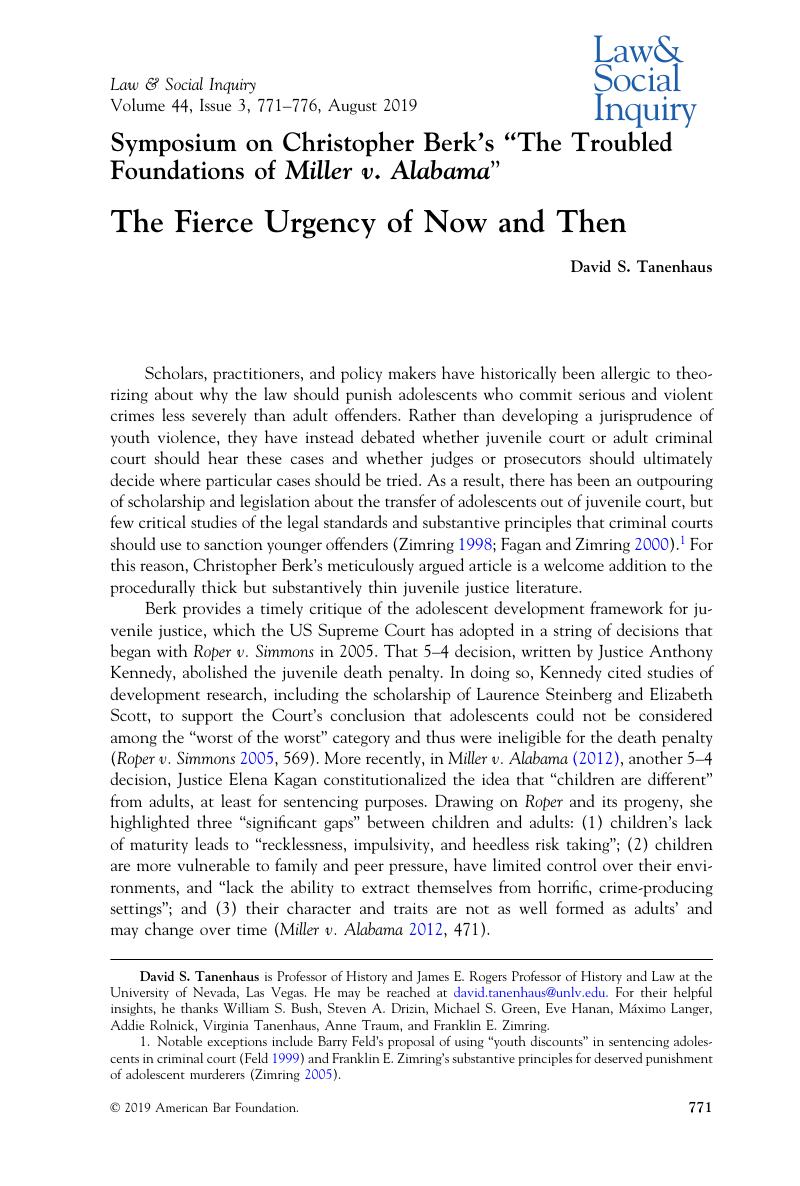No CrossRef data available.
Article contents
The Fierce Urgency of Now and Then
Published online by Cambridge University Press: 18 July 2019
Abstract
An abstract is not available for this content so a preview has been provided. Please use the Get access link above for information on how to access this content.

- Type
- Symposium on Christopher Berk’s “The Troubled Foundations of Miller v. Alabama”
- Information
- Copyright
- © 2019 American Bar Foundation
References
REFERENCES
Agyepong, Tera. “Children Left Behind Bars: Sullivan, Graham, and Juvenile Life Without Parole Sentences.” Northwestern Journal of International Human Rights Law 9, no. 1 (2010): 83–102.Google Scholar
Berk, Christopher. “Children, Development, and the Troubled Foundations of Miller v. Alabama.” Law & Social Inquiry 43, no. 3 (2019), https://doi.org/10.1017/lsi.2018.18.CrossRefGoogle Scholar
Bush, William S., and Tanenhaus, David S.. Ages of Anxiety: Juvenile Justice in Historical and Transnational Perspective. New York: New York University Press, 2018.Google Scholar
Fagan, Jeffrey, and Zimring, Franklin E.. The Changing Borders of Juvenile Justice: Transfer of Adolescents to Criminal Court. Chicago: University of Chicago Press, 2000.Google Scholar
Feld, Barry C. Bad Kids: Race and the Transformation of the Juvenile Court. New York: Oxford University Press, 1999.Google Scholar
Grisso, Thomas. “Society’s Retributive Response to Juvenile Violence: A Developmental Perspective.” Law and Human Behavior 20, no. 3 (1996): 229–247.CrossRefGoogle Scholar
“Juvenile Prosecution Policy Positions and Guidelines,” prepared by Caren Harp, National Juvenile Justice Prosecutor Center (July 5, 2016).Google Scholar
Ketchum, Orman W. “The Unfulfilled Promise of the Juvenile Court.” Crime & Delinquency 7, no. 2 (1961): 97–110.CrossRefGoogle Scholar
Langer, Máximo, and Tanenhaus, David S.. “American Juvenile Justice and the Overlooked Origins and Consequences of the Adversary System.” Paper presented at the Criminal Justice Roundtable, Cambridge, MA, May 4, 2018.Google Scholar
Maroney, Terry A. “The False Promise of Adolescent Brain Science in Juvenile Justice.” Norte Dame Law Review 85 (2009): 89–176.Google Scholar
Maroney, Terry A. “The Once and Future Juvenile Brain.” In Choosing the Future for American Juvenile Justice, edited by Zimring, Franklin E. and Tanenhaus, David S., 189–215. New York: New York University Press, 2014.CrossRefGoogle Scholar
“Mission Statement.” Office of Juvenile Justice and Delinquency Prevention. https://www.ojjdp.gov/about/missionstatement.html.Google Scholar
Tanenhaus, David S., and Drizin, Steven A.. “‘Owning the Extreme Youth of the Accused’: The Changing Legal Response to Juvenile Homicide.” Journal of Criminal Law & Criminology 92, no. 3-4 (2001–2002): 641–706.CrossRefGoogle Scholar
Torbet, Patricia, et al. State Responses to Serious and Violent Juvenile Crime. Pittsburgh, PA: National Center for Juvenile Justice, 1996.Google Scholar
Transcript of Oral Argument, Roper v. Simmons, 543 U.S. 551 (No. 03-633) (October 13, 2004), https://www.supremecourt.gov/oral_arguments/argument_transcripts/2004/03-633.pdf.Google Scholar
Woolard, Jennifer, Reppucci, N. Dickon, and Redding, Richard E.. “Theoretical and Methodological Issues in Studying Children’s Capacities in Legal Contexts.” Law and Human Behavior 20, no. 3 (1996): 219–228.CrossRefGoogle Scholar
Zimring, Franklin E. “Toward a Jurisprudence of Youth Violence.” Crime and Justice 24 (1998): 477–501.CrossRefGoogle Scholar
Zimring, Franklin E. American Juvenile Justice. New York: Oxford University Press, 2005.CrossRefGoogle Scholar
Yaffe, Gideon. The Age of Culpability: Children and the Nature of Criminal Responsibility. New Haven, CT: Yale University Press, 2018.CrossRefGoogle Scholar


